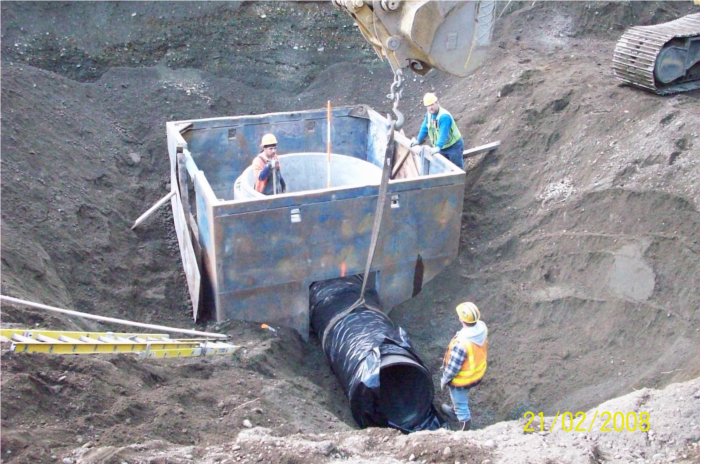November 2009 Vol. 64 No. 11
Features
Military Base Sewer System Upgraded With HDPE Pipe

The recent expansion of the sanitary sewer system at Ft. Lewis, WA, included the installation of 5,000 feet of 36 inch and 400 feet of 30 inch diameter HDPE pipe to replace the base’s vitrified clay system.
Design and construction work was done by Bristol Construction Services LLC, Anchorage, AK. Bristol provides heavy construction, construction management, civil engineering and other services to the U.S. Army Corp. of Engineers, NAVFAC and the FAA in Alaska, Washington and North Carolina.
Ft. Lewis is home to I Corp and is one of the largest military reservations in the United States. Named after explorer Meriwether Lewis, it was established in just before World War I and now has 30,000 soldiers, 11,000 civilian employees, 24,000 retirees and 47,000 family members living both on and off the post.
Recent plans called for the expansion of Ft. Lewis for which the new sanitary sewer system will provide additional capacity. This meant that the sewer system would be upgraded to include large diameter pipe. The existing 24 inch clay pipe was half-full, leaking and also taking on water that infiltrated from the soil, unnecessarily adding a burden to the treatment plant.
Originally, the replacement pipe was to be polyvinyl chloride (PVC), but because of its higher cost, Bristol selected the HDPE pipe, and the Army Corp of Engineers agreed.
“The main problem with the existing sanitary sewer line,” explained John Sharp, project manager for Bristol, “was that it was already undersized for the needs of Ft. Lewis, and would not be capable of meeting the expansion plans. In addition, the vitrified clay was taking on water, so the sewage treatment plant was having a hard time processing all that extra ground water when there was a significant storm.”
The new pipeline was installed parallel to the old one so there was little interruption to base operations. Working six days a week, the Bristol crew of eight used a CAT 365 excavator that would dig the ditch and drag the trench box along. After the ditch was excavated and the box set in place, bedding would be put down to set the grade of less than a half of a percent.
“Production was great. We made very good time on the job. The pipe was fairly light. It was moved into position with the excavator,” Sharp stated. “A three-man crew was in the trench to connect the pipe sections.”
At some locations, such as the firing range, the trench was 25-feet deep. “That particular section of pipe was passing through firing ranges so you have the normal grade of about 10 feet and then another 15 feet of berm,” he said.
Because of the size of the pipe, precast concrete manholes that are at least 72-inches in diameter at the bottom, and tapering to 48 inches at the top were used. Some larger 84 inch manholes were used to accommodate three pipes – two coming in and one out.
After the pipe was put into place, it took about 20 days to do all the tie ins.
“We started at the high side and worked down,” Sharp explained. “We would stop one stick short of the manhole, and didn’t tie into it. Then, we’d put in the whole line, go to the very bottom and stop one stick short again, excavate for the manhole, expose it and the pipe on both sides. The existing line would then be exposed and we brought in a system of 8 inch bypass pumps with triple bypass so we would have one workhorse and two back pumps. This was just in case one couldn’t keep up or broke down. We pumped the sewage around the tie in point, capped it off, cut the pipe open and installed the manhole.
“We used a channel manhole for that because it’s open at the bottom and could be slipped over the top of the pipe,” Sharp continued. “The crew did the grouting, got it all buttoned up, brought the new line into the manhole, took the plug out and connected to the pumps. We then did the same on the opposite side, and made sure everything was tested before we did that.”
The Hancor HDPE pipe is designed specifically for sanitary sewer systems which are usually buried deeper and subjected to greater water pressure than corrugated HDPE pipe used for storm sewer installations. According to Sheehy, two types of Hancor HDPE pipe were used – SantiTite Sanitary Sewer pipe and Low Head pipe. “Both provided the necessary water tight seal between pipe sections,” he explained.
Since 1917, Ft. Lewis has been serving the country. With the projected life expectancy of HDPE pipe listed at 100 years, the property will be at least 200 years old when it next might need a new sewer system.
FOR MORE INFORMATION:
Hancor, (888) 367-7473, www.hancor.com




Comments